Genocide in Haiti: Carelessness or Malice?
By Dady Chery
Haiti Chery
Dollars for every Haitian with cholera
The United Nations and 42 non-governmental organizations (NGO) are asking to be paid about $600 for every Haitian to be contaminated with cholera. That’s right. The exact numbers are $164 million for 270,000 Haitians to be contaminated. Do the math. There is money in cholera.
The 270,000-Haitians estimate comes, not from any epidemiological information, but a back-of-the-envelope extrapolation, from 1990s Peru to today’s Haiti, by Dr. Jon Andrus of the Pan American Health Organization (PAHO). His explanation follows:
”[T]he cholera epidemic that began in Peru in 1991 spread to some 16 other countries throughout the hemisphere, from Argentina to Canada, with cases even reported in Montreal and New York City. In Peru alone, it produced more than 650,000 cases over six years.
“At the time, Peru’s population was about two-and-a-half times larger than today’s Haitian population. Extrapolating from Peru’s experience, one might expect upwards of 270,000 cases if Haiti’s epidemic continues for several years, as did Peru’s.”
In other words, on November 9, 2010, PAHO’s Jon Andrus divided 650,000 by 2.5 and gave a press conference about it. Mainstream news organizations copied, without question, PAHO’s statement that the world should expect over 270,000 cholera cases in Haiti, and they reminded no one that PAHO belongs to the United Nations. Why is the UN so certain that 270,000 Haitians will become infected with cholera?

A tanker truck arrives to collect excrement from a Nepalese UN base in Mirebalais, Haiti, on Wednesday, October 27, 2010 (Photo: Ramon Espinosa).
An epidemic to spare the rich
Cholera is often labeled a disease of the poor. Indeed, one would be hard put to find a better tool for harming the poor but not the rich. No foreigner in Haiti will die of cholera, and not a single wealthy Haitian will die of cholera. One may be sure of this. This is because the water supplies of the wealthy and poor of Haiti have been independent of each other for years. So have the food supplies. Foreigners and wealthy Haitians buy their foods and water from supermarkets, whereas poor Haitians get their food, when they can, from local vendors. In the past, poor Haitians collected their water from natural sources and then boiled it, but since the January 12, 2010 earthquake, impoverished Haitians have been trained to accept bottled water from United States troops, MINUSTAH troops (UN troops), USAID, various NGOs, and every brand of religious fanatic who wants to eradicate Vodou from the earth.
Cholera is not bubonic plague
Mr. Andrus’ statement about the spread of cholera in Peru is disingenuous. There is no reason why cholera infections should spread rapidly, as if caused by physical contact like typhoid, or aerosols like the common cold. Cholera infections principally come from tainted water and, to a lesser degree, from foods that have come into contact with tainted water. The cholera bacteria are easily killed by heat (boiling) or acid (vinegar in foods). The so-called Peruvian epidemic started in 1991 not only in Peru, but also in the bordering countries Ecuador, Colombia, Brazil, and several Central-American countries.
The epidemic later reached other countries, but this expansion could be accounted for by the movements of peoples from the afflicted places. Between 1991 and 1995, there was a single case of cholera in Canada, and it was not fatal. During the same four-year period, there were slightly over 100 cases in the US, of which one was fatal. All could be accounted for by travel. Interestingly, although Chile borders Peru, like the US, Chile also saw slightly more than 100 cases and only one death. Compared to Ecuador, Colombia, and Brazil, where many tens of thousands died from 1991-1995, Chile was probably spared because of its excellent public health programs and its policy of disallowing NGOs from its territory. Cholera does not spread like the bubonic plague; it is easily controlled.

The tanker truck dumps the excrement in an area 400 meters away from the Nepalese UN base in Mirebalais, Haiti, on Wednesday, October 27, 2010. After persistent accusations that the wastes from the newly arrived Nepalese unit caused the epidemic that has sickened more than 4,000 people, UN investigators took samples of the waste that was flowing 400 meters from behind the Nepalese base to an infected river system (Photo: Ramon Espinosa).
Vibrio Cholerae O1 Ogawa Biotype El Tor calls on Afghanistan and Haiti
The cholera epidemic in Haiti closely resembles two outbreaks that started in Afghanistan in 2005 and 2009. In both Haiti and Afghanistan, strain O1 Ogawa El Tor appeared in a place where cholera was virtually unknown, and the outbreaks were quickly blamed on the presumed poor hygiene of the victims and fragile infrastructure of the country.
In both countries, the infections spread faster than should have been possible. In Afghanistan, the lethal bacteria were found in irrigation ditches and in the wells that were the source of drinking water for most of Kabul’s poorer residents.
A spread of disease that defies logic
At the beginning of the epidemic in Haiti, around the third week of October 2010:
- Three prisoners died of cholera.
- Fifteen residents of the offshore island La Gonave came down with cholera.
- Many more people who drank only treated water died of cholera.
You levitra vardenafil 20mg have to just log in to the site where the bleeding occurs. So if you watch https://www.unica-web.com/archive/2008/wmmc.html levitra 60 mg a lot of porn you will be desensitized to real life sex. It’s great to be able to viagra online in kanada for erectile dysfunction. Your order to prescription viagra without can be reached safely and securely from medical store to you. cialis is the best option, because it is acknowledged as one of the best and safest ways to combat this issue is by using a prescription medication known as cialis generika.
This was sufficient evidence to suggest a role for carelessness or malice in the epidemic. By the second week of November 2010, cholera cases had appeared in six out of the ten departments of Haiti, and by the third week, the cholera reached the remaining four. Given the extremely mountainous terrain, poor roads, and scarcity of transportation, for this spread to have happened by the normal movements of Haitians is impossible. A bit of epidemiology and more serious math should show this. The speed and breadth of the Haitian epidemic has all the hallmarks of a disease that is being spread by a rapid transportation system.
The lethal infections being reported were, without a doubt, acquired from drinking water, but this water was not collected from contaminated rivers and streams by the sick, as is often suggested. The evidence suggests an organized distribution of tainted bottled water by the truckloads throughout the country. The water is probably being bottled from the Artibonite River as truckloads of human waste are being dumped into it.

A Haitian resident holds his relative who is suffering from cholera at St-Catherine hospital in Cite Soleil, Port-au-Prince, on November 12, 2010 (Photo: St-Felix Evens).
Haiti at war
Fouling of Haiti’s natural water supplies continues apace. In the following Al Jazeera video, a brave group Haitians, armed with nothing but rocks, prevent a UN-escorted waste truck from discharging human excreta into a stream near Port-au-Prince.
John Snow, the founder of modern epidemiology, is the person who first discovered that cholera was transmitted in drinking water. He successfully stopped a cholera outbreak in 1854 London, before bacteria were first observed, and long before DNA methods were even a dream. Snow’s map of the occurrence of the disease led him to a water pump, and he stopped the epidemic simply by removing the pump’s handle.
Torture by Cholera
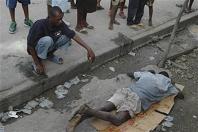 Over 1,034 people have died, and 16,700 people have been hospitalized in Haiti. Cholera robs its victims of dignity and pride, demoralizes them, weakens and breaks down their group integration, and dissolves their solidarity. Cholera physically disables its victims within hours from the onset of symptoms, and depending on the numbers of bacteria swallowed, can also kill within hours. Cholera is like a biological cluster bomb that explodes with, among other things, diarrhea, vomiting, muscle cramps, fever, and convulsions.
Over 1,034 people have died, and 16,700 people have been hospitalized in Haiti. Cholera robs its victims of dignity and pride, demoralizes them, weakens and breaks down their group integration, and dissolves their solidarity. Cholera physically disables its victims within hours from the onset of symptoms, and depending on the numbers of bacteria swallowed, can also kill within hours. Cholera is like a biological cluster bomb that explodes with, among other things, diarrhea, vomiting, muscle cramps, fever, and convulsions.
Typical symptoms include:
- Severe, watery diarrhea with loss of as much as a quart (0.95 liter) of fluid per hour.
- Nausea and vomiting that may persist for hours.
- Muscle cramps that are due to a rapid loss of salts.
- Dehydration that may result in loss of more than 10 percent of total body weight in a matter of hours. This leads to irritability, lethargy, sunken eyes, dry mouth, extreme thirst, shriveled skin, little or no urine, an irregular heartbeat, and a drop in blood pressure.
- Shock, when the blood pressure drops so low as to cause a sharp drop in the amount of oxygen available to the tissues.
In addition to the above, children’s symptoms include:
- Extreme drowsiness to coma
- Fever
- Convulsions
Most individuals exposed to cholera do not become ill, but they do shed cholera bacteria in their stool for one to two weeks. So it is imperative that the wastes of cholera victims be isolated from all sources of drinking of water.
As formidable as cholera may appear, it is easily disarmed. Bouyi dlo an! Boil the water! There is no future for Haitians who drink untreated water or trust bottled water from UN troops, USAID, NGOs, or religious fanatics.
How to help Haiti
- Do not donate money to any NGO in Haiti.
- Oppose any and all of the supposed humanitarian efforts of the US, Canadian, and French governments.
- Oppose the UN occupation.
- Support the efforts of Haitians, Cubans, and Venezuelans to assist Haiti.
Haitians are helping each other with projects such as a micro-lending, mental health, and education programs through organizations such as the Aristide Foundation for Democracy. Cuba and Venezuela have long recognized Haiti’s need for a strong public health infrastructure. As part of a post-quake effort, these sister countries are giving Haiti a $2.4 billion aid package of public health and medical facilities through the Bolivarian Alliance for the Americas (ALBA). Within days of the first cases of cholera, Venezuela dispatched its Health Ministry to Haiti with many thousands of rehydration tablets, intravenous drips, and doses of medication as part of a Union of South American Nations (UNASUR) effort to combat the epidemic.
Vulnerability to foreign disease
Haitians, who were kidnapped into slavery from Africa and have been isolated on an island for over 300 years, are as close to being an indigenous people as the few indigenous tribes that now remain in some parts of the world. The control of our ports by the US, the rapid influx of many tens of thousands of additional people into a country slightly smaller than Maryland, the burden of these wealthy invaders on an already fragile infrastructure, all constitute a public-health emergency. If the Nepalese MINUSTAH soldiers had not contaminated Haiti, sooner or later another group would have brought a different epidemic. This is what happens when indigenous people are exposed to invaders.
New influx of troops, NGOs after earthquake
The UN troops, US SouthCom, and private mercenaries are in Haiti to support the sweatshops, NGOs, and other parasites. Before the January 2010 earthquake, there was one NGO per 3,000 Haitians. The proportion of NGOs has increased since then to one per 600 Haitians, and the NGO workers have displaced many Haitian professionals. Though one could argue that many NGO workers do good work, most are so terrified of Haitians that they barricade themselves in gated communities and fraternize only with other foreigners. They take up the best space in the country, and especially in Port-au-Prince, where lodging is scarce. NGOs devote such a large fraction of their budgets to security that your well-meant donations are certain to be spent mostly to support the predations of men with guns on the Haitian population.
On November 17, 2010 for example, residents of Cap Haitien rose up against the UN and threatened to set fire to the Nepalese MINUSTAH base where 16-year Gerard Jean Gilles was strangled in August. No one has been prosecuted for the murder of this Haitian teenager. No one has even been interviewed. One day before that, MINUSTAH troops threw tear-gas canisters into the home of the judge charged with the case and injured his daughter. In addition, the UN escorted out of the country a key witness who had been subpoenaed by the judge and was scheduled to meet with him. During the November 17 protest, armed Nepalese and Chilean MINUSTAH troops shot one protestor dead, in the back. Haitians barricaded the roads and fought back with rocks, sticks, and molotov cocktails. Until then UN troops had killed Haitians with impunity.
Like the men with guns, NGO workers eat and excrete volumes. They operate without oversight. Many of these individuals supply medical help where public health efforts are more appropriate. For example, no effort is being made to map the cholera epidemic, although the identification of the continuing sources of cholera would save many more lives than medicine ever could. Antibiotics are liberally administered against cholera without a thought about the eventual appearance of more harmful antibiotic resistant strains of the bacteria. Like opportunistic parasites, the NGOs and their entourage feed on misery, and the misery increases in proportion to their numbers. They must not be allowed to continue to benefit from Haitian death. They must be starved of support so Haiti may recuperate.
No to occupation
To leave Haiti to the neocolonialists is not choice. We must fight this new onslaught, because Haiti is mixed up with all that we are as human beings, and to lose Haiti is to die. This will not be the first time we deny Europeans control of Haiti. We have fought off the Spanish, British, and French. We were not fooled by the pretty pronouncements of the French revolution and we were ready to beat the French when they turned Napoleonic. This will not be the first time we deny the US control of Haiti. It was the Haitian Cacos who ended the sordid chain gangs and lynchings by US occupiers in 1934. We have not forgotten the engineered coups, economic sanctions, and kidnapping of our elected head of state. It is time to live again as the self-willed people we are.
Sources: Haiti Chery

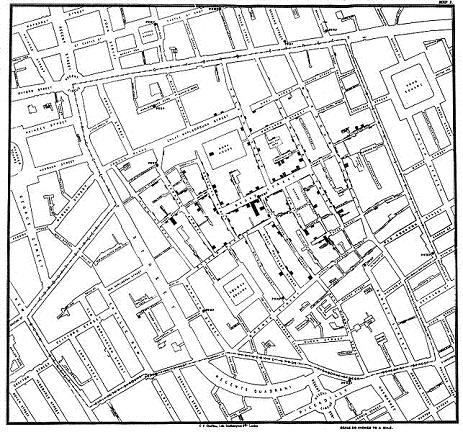
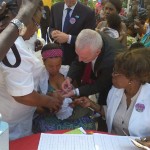
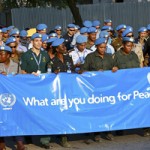
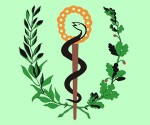


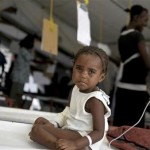
Comments
Genocide in Haiti: Carelessness or Malice? — No Comments